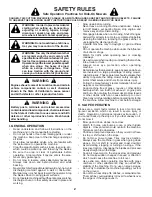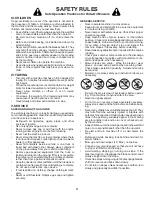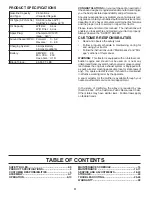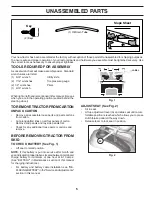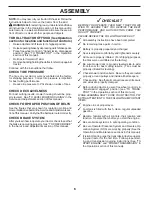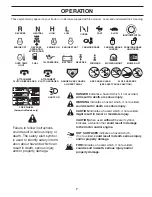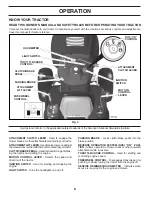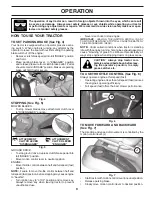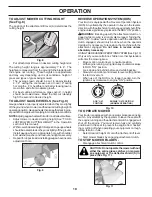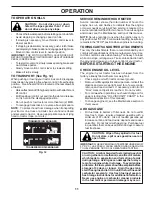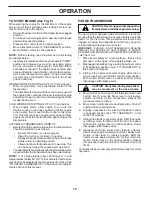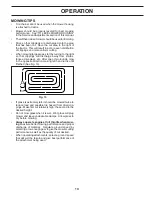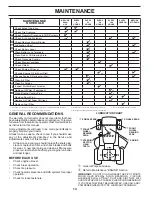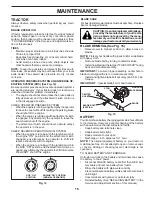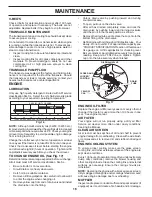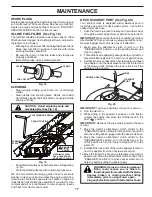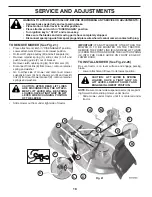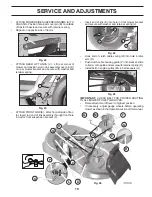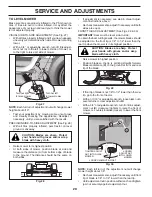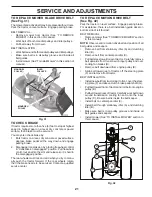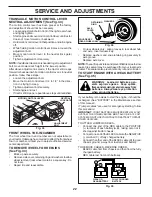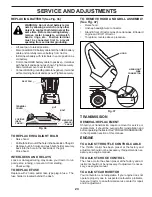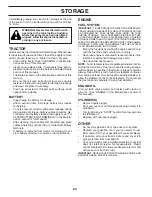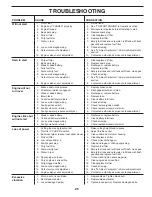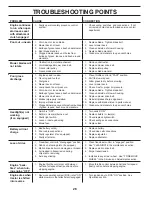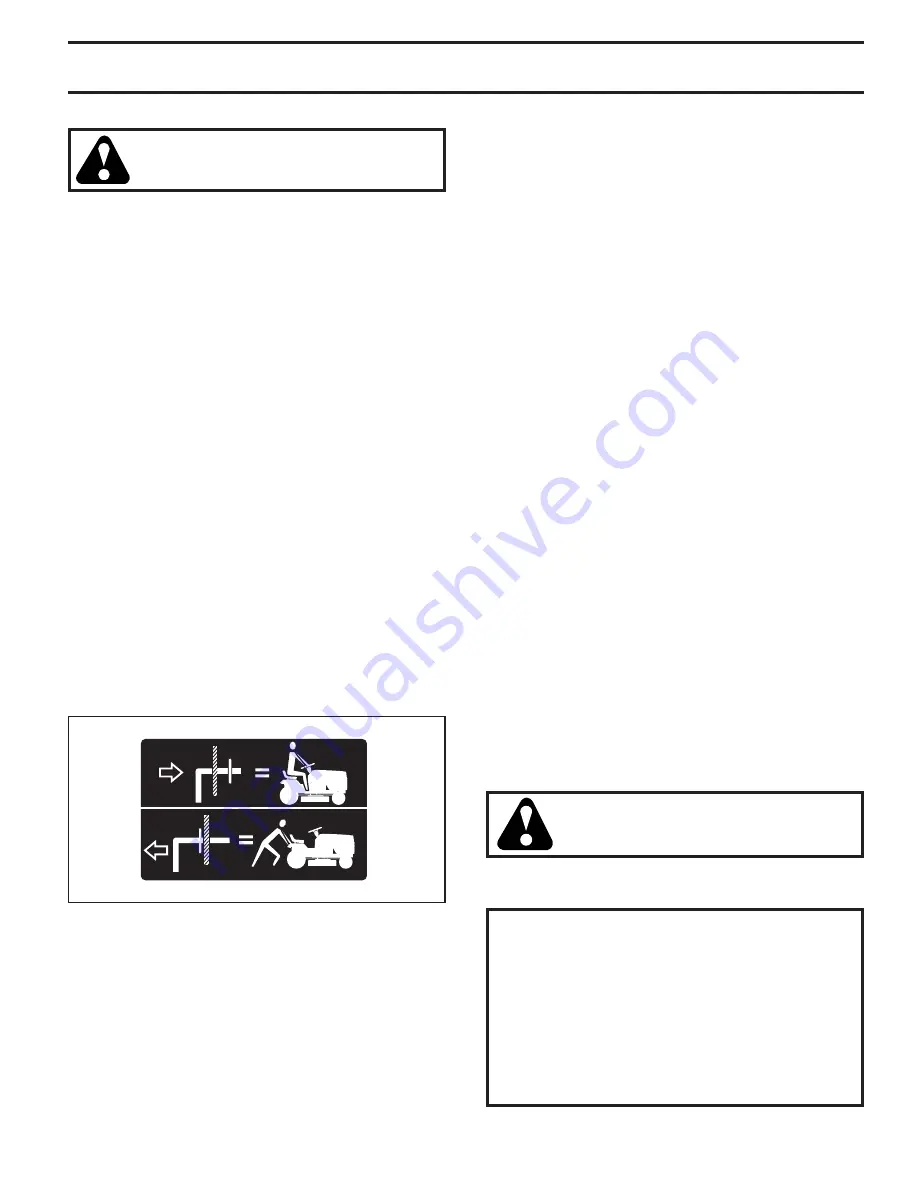
11
TOWING CARTS AND OTHER AT TACH MENTS
Tow only the attachments that are recommended by and
comply with specifications of the manufacturer of your trac-
tor. Use common sense when towing. Too heavy of a load,
while on a slope, is dangerous. Tires can lose traction with
the ground and cause you to lose control of your tractor.
BEFORE STARTING THE ENGINE
CHECK ENGINE OIL LEVEL
The engine in your tractor has been shipped, from the
factory, already filled with sum mer weight oil.
TO OPERATE ON HILLS
CAUTION: Do not drive up or down
hills with slopes greater than 15° and
do not drive across any slope.
•
Choose the lowest speed before starting up or down hills.
• Avoid stopping or changing speed on hills.
• If slowing is necessary, move throttle control lever to
slower position.
• If stopping is absolutely necessary, push clutch/brake
pedal quickly to brake position and engage parking brake.
• Move motion control lever to neutral position.
IMPORTANT:
THE MOTION CONTROL LEVER DOES NOT
RETURN TO NEUTRAL POSITION WHEN THE CLUTCH/BRAKE
PED AL IS DEPRESSED.
•
To restart movement, slowly release parking brake and
clutch/brake pedal.
• Slowly move motion control lever to slowest setting.
• Make all turns slowly.
TO TRANSPORT (See Fig. 12)
When pushing or towing your tractor, be sure to disengage
transmission by placing freewheel control in free wheel ing
po si tion. Free wheel control is located at the rear drawbar
of tractor.
•
Raise attachment lift to highest position with at tach ment
lift control.
•
Pull freewheel control out and into the slot and release
so it is held in the disengaged position.
• Do not push or tow tractor at more than two (2) MPH.
• To reengage transmission, reverse above procedure.
NOTE
: To protect hood from damage when transporting
your tractor on a truck or a trailer, be sure hood is closed
and secured to tractor. Use an appropriate means of tying
hood to tractor (rope, cord, etc.).
• Check engine oil with tractor on level ground.
•
Remove oil fill cap/dipstick and wipe clean, reinsert the
dipstick and screw cap tight, wait for a few seconds,
remove and read oil level. If necessary, add oil until
“FULL” mark on dipstick is reached. Do not overfill.
• For cold weather operation you should change oil for
easier starting (See “OIL VISCOSITY CHART” in the
Maintenance sec tion of this manual).
• To change engine oil, see the Maintenance section in
this manual.
OPERATION
TRANSMISSION ENGAGED
TRANSMISSION DISENGAGED
Fig. 12
SERVICE REMINDER/HOUR METER
Service reminder shows the total number of hours the
engine has run and flashes to indicate that the engine
or mower needs servicing. When service is required, the
service reminder will flash for two hours. To service engine
and mower, see the Maintenance section of this manual.
NOTE
: Service reminder runs when the ignition key is in
any position but "STOP". For accurate reading, be sure key
remains in the "STOP" position when engine is not running.
ADD GASOLINE
• Fill fuel tank to bottom of filler neck. Do not overfill.
Use fresh, clean, regular un lead ed gasoline with a
minimum of 87 octane. (Use of leaded gasoline will
increase carbon and lead oxide deposits and reduce
valve life). Do not mix oil with gasoline. Purchase fuel
in quan ti ties that can be used within 30 days to assure
fuel freshness.
CAUTION: Wipe off any spilled oil or fuel.
Do not store, spill or use gasoline near an
open flame.
IMPORTANT:
WHEN OPERATING IN TEMPERATURES BELOW
32°F(0°C), USE FRESH, CLEAN WINTER GRADE GAS O LINE
TO HELP ENSURE GOOD COLD WEATHER START ING.
CAUTION: Alcohol blended fuels (called gas o hol
or using ethanol or methanol) can attract moisture
which leads to sep a ra tion and for ma tion of acids
during storage. Acidic gas can damage the fuel sys-
tem of an engine while in storage. To avoid engine
problems, the fuel system should be emptied before
stor age of 30 days or longer. Drain the gas tank,
start the engine and let it run until the fuel lines and
carburetor are empty. Use fresh fuel next sea son.
See Storage In struc tions for additional information.
Never use engine or carburetor cleaner products
in the fuel tank or permanent damage may occur.


